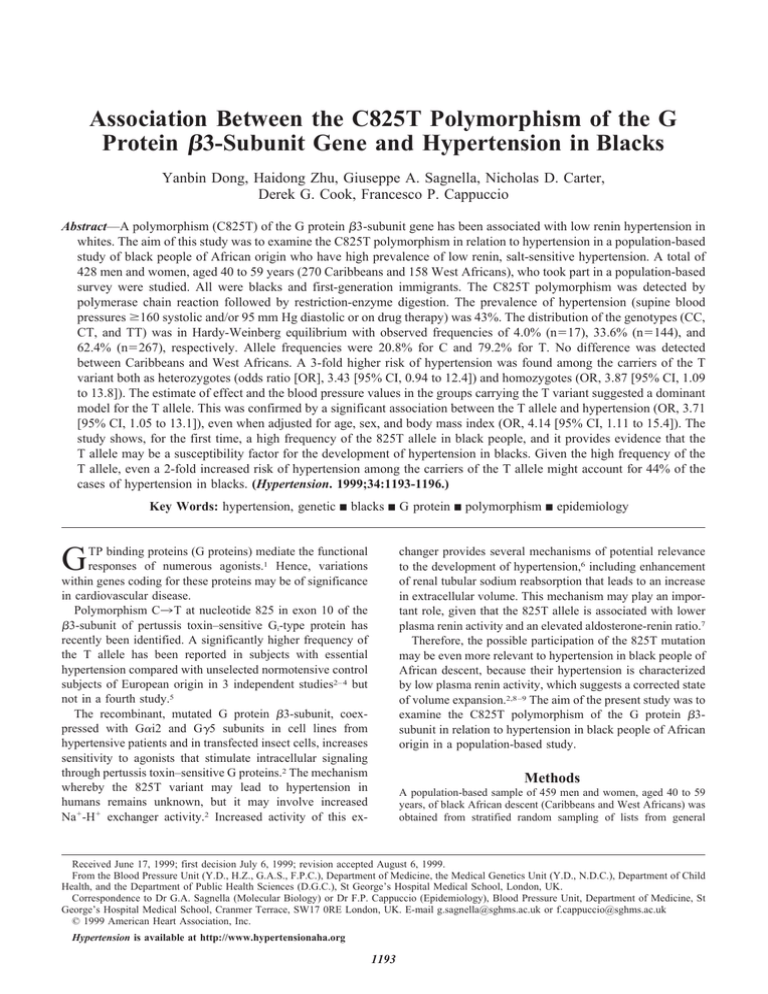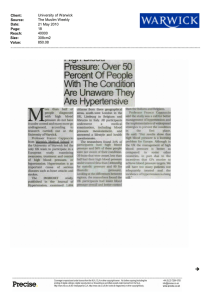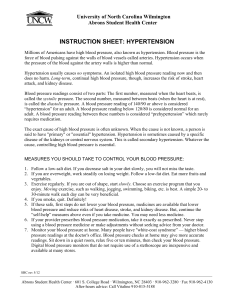b Association Between the C825T Polymorphism of the G Protein
advertisement

Association Between the C825T Polymorphism of the G
Protein b3-Subunit Gene and Hypertension in Blacks
Yanbin Dong, Haidong Zhu, Giuseppe A. Sagnella, Nicholas D. Carter,
Derek G. Cook, Francesco P. Cappuccio
Abstract—A polymorphism (C825T) of the G protein b3-subunit gene has been associated with low renin hypertension in
whites. The aim of this study was to examine the C825T polymorphism in relation to hypertension in a population-based
study of black people of African origin who have high prevalence of low renin, salt-sensitive hypertension. A total of
428 men and women, aged 40 to 59 years (270 Caribbeans and 158 West Africans), who took part in a population-based
survey were studied. All were blacks and first-generation immigrants. The C825T polymorphism was detected by
polymerase chain reaction followed by restriction-enzyme digestion. The prevalence of hypertension (supine blood
pressures $160 systolic and/or 95 mm Hg diastolic or on drug therapy) was 43%. The distribution of the genotypes (CC,
CT, and TT) was in Hardy-Weinberg equilibrium with observed frequencies of 4.0% (n517), 33.6% (n5144), and
62.4% (n5267), respectively. Allele frequencies were 20.8% for C and 79.2% for T. No difference was detected
between Caribbeans and West Africans. A 3-fold higher risk of hypertension was found among the carriers of the T
variant both as heterozygotes (odds ratio [OR], 3.43 [95% CI, 0.94 to 12.4]) and homozygotes (OR, 3.87 [95% CI, 1.09
to 13.8]). The estimate of effect and the blood pressure values in the groups carrying the T variant suggested a dominant
model for the T allele. This was confirmed by a significant association between the T allele and hypertension (OR, 3.71
[95% CI, 1.05 to 13.1]), even when adjusted for age, sex, and body mass index (OR, 4.14 [95% CI, 1.11 to 15.4]). The
study shows, for the first time, a high frequency of the 825T allele in black people, and it provides evidence that the
T allele may be a susceptibility factor for the development of hypertension in blacks. Given the high frequency of the
T allele, even a 2-fold increased risk of hypertension among the carriers of the T allele might account for 44% of the
cases of hypertension in blacks. (Hypertension. 1999;34:1193-1196.)
Key Words: hypertension, genetic n blacks n G protein n polymorphism n epidemiology
G
changer provides several mechanisms of potential relevance
to the development of hypertension,6 including enhancement
of renal tubular sodium reabsorption that leads to an increase
in extracellular volume. This mechanism may play an important role, given that the 825T allele is associated with lower
plasma renin activity and an elevated aldosterone-renin ratio.7
Therefore, the possible participation of the 825T mutation
may be even more relevant to hypertension in black people of
African descent, because their hypertension is characterized
by low plasma renin activity, which suggests a corrected state
of volume expansion.2,8 –9 The aim of the present study was to
examine the C825T polymorphism of the G protein b3subunit in relation to hypertension in black people of African
origin in a population-based study.
TP binding proteins (G proteins) mediate the functional
responses of numerous agonists.1 Hence, variations
within genes coding for these proteins may be of significance
in cardiovascular disease.
Polymorphism C3 T at nucleotide 825 in exon 10 of the
b3-subunit of pertussis toxin–sensitive Gi-type protein has
recently been identified. A significantly higher frequency of
the T allele has been reported in subjects with essential
hypertension compared with unselected normotensive control
subjects of European origin in 3 independent studies2– 4 but
not in a fourth study.5
The recombinant, mutated G protein b3-subunit, coexpressed with Gai2 and Gg5 subunits in cell lines from
hypertensive patients and in transfected insect cells, increases
sensitivity to agonists that stimulate intracellular signaling
through pertussis toxin–sensitive G proteins.2 The mechanism
whereby the 825T variant may lead to hypertension in
humans remains unknown, but it may involve increased
Na1-H1 exchanger activity.2 Increased activity of this ex-
Methods
A population-based sample of 459 men and women, aged 40 to 59
years, of black African descent (Caribbeans and West Africans) was
obtained from stratified random sampling of lists from general
Received June 17, 1999; first decision July 6, 1999; revision accepted August 6, 1999.
From the Blood Pressure Unit (Y.D., H.Z., G.A.S., F.P.C.), Department of Medicine, the Medical Genetics Unit (Y.D., N.D.C.), Department of Child
Health, and the Department of Public Health Sciences (D.G.C.), St George’s Hospital Medical School, London, UK.
Correspondence to Dr G.A. Sagnella (Molecular Biology) or Dr F.P. Cappuccio (Epidemiology), Blood Pressure Unit, Department of Medicine, St
George’s Hospital Medical School, Cranmer Terrace, SW17 0RE London, UK. E-mail g.sagnella@sghms.ac.uk or f.cappuccio@sghms.ac.uk
© 1999 American Heart Association, Inc.
Hypertension is available at http://www.hypertensionaha.org
1193
1194
Hypertension
TABLE 1.
December 1999
Characteristics of Participants According to C825T Genotype
Genotype
CC
CT
TT
P*
29.761.0 (17)
28.260.4 (144)
28.460.3 (265)
0.37
Systolic
130.264.7 (17)
135.661.6 (144)
135.261.2 (267)
0.55
Diastolic
83.562.5 (17)
85.860.8 (144)
86.860.6 (144)
0.29
3 (17.6)
47 (32.6)
92 (34.5)
139.660.7 (17)
139.560.2 (140)
140.060.2 (265)
Measurement
Body mass index, kg/m2
Blood pressure, mm Hg
On treatment, n (%)
Serum
Sodium, mmol/L
0.22
Potassium, mmol/L
4.2260.07 (17)
4.1660.02 (140)
4.1360.02 (265)
0.40
Creatinine, mmol/L
88.763.6 (17)
92.361.2 (140)
92.060.9 (265)
0.63
311645 (17)
367616 (138)
336611 (261)
0.21
Plasma aldosterone, pmol/L
Characteristics are adjusted for age and sex. All values are mean6SE unless otherwise indicated. Values in
parentheses indicate number of subjects.
*P for heterogeneity by ANCOVA.
practices in South London as previously described.9 –10 Participants
were all first-generation immigrants. Ethnic group was recorded at
the time of interview.9 All participants gave informed consent to
participate in the study, which was approved by the local ethics
committee. Participants attended a dedicated screening unit at St.
George’s Hospital between 8 AM and 12 PM after an overnight fast.
Anthropometry and blood pressure measurements were performed as
previously described.9 –11 Details of blood collections for DNA,
routine serum electrolytes, plasma aldosterone, and urine collections
were also as described.9 –11 Hypertension was defined as supine
systolic blood pressure $160 and/or diastolic blood pressure
$95 mm Hg or being on antihypertensive treatment.
Genetic Analysis
Genomic DNA was isolated from whole blood using Nucleon BACC
DNA extraction kit.11 The C825T polymorphism was detected by
PCR followed by BseDI (MBI Fermentas) restriction-enzyme digestion as described previously, with minor modifications;2 products
were separated on 2% agarose gels and visualized under UV light by
ethidium bromide staining. Genotype was confirmed by direct
sequence analysis with the use of a dye terminator kit on an ABI 377
automated sequencer. To prevent observer bias, the investigator was
unaware of sample origin and all gels were cross checked by a
separate individual. Valid genotyping was obtained in a total of 428
black individuals (93.2%). The characteristics of those not genotyped
(6.8%) did not differ from the rest of the population (data not
shown).
Statistical Analysis
The calculation of allele frequency to test for Hardy-Weinberg equilibrium was performed by use of standard methods.12 Associations
between hypertension and genotype were tested with x2 tests. Multiple
logistic regression was used to test the effect of genotype on the
likelihood of hypertension while controlling for confounding factors.
Accordingly, the association between presence of hypertension and
genotype was tested by calculating odds ratios (ORs) under a dominant
model with scores of 0 for CC and 1 for the TC and the TT genotypes
combined. When appropriate, 1-way ANCOVA was used for comparisons of group means adjusted for confounders. To study the attributable
risk of hypertension to the presence of the T variant, populationattributable risk percent (PAR%) was estimated as follows:
PAR%5{[(PrevE)(OR21)]/11[(PrevE)(OR-1)]}3100, where PrevE is
the prevalence of the exposure (T allele frequency) and OR is the
estimated OR of the association between the T allele and the presence
of hypertension.13 Group values are given as mean6SE.
Results
Frequencies of genotypes CC, CT, and TT in the whole
group were in Hardy-Weinberg equilibrium with observed
frequencies of 4.0% (n517), 33.6% (n5144), and 62.4%
(n5267), respectively, and frequencies of 20.8% for C and
79.2% for T allele. No significant difference existed in
frequencies between West Africans (n5158; 2.5%, 30.4%,
and 67.1% for CC, CT, and TT, respectively) or Caribbeans (n5270; 4.8%, 35.6%, and 59.6% for CC, CT, and TT,
respectively). No significant differences existed in ageand sex-adjusted characteristics by genotype (Table 1). A
higher prevalence of hypertension was seen among the
carriers of the T variant (both as heterozygotes and
homozygotes) compared with the CC genotype, even after
adjustment for age, sex, and body mass index (x2 for
trend52.91; P50.08) (Table 2). Although the association
was of borderline significance, the estimate of effect
suggested the possibility of a dominant model for the T
allele. In addition, the blood pressures (when adjusted for
age and sex) tended to be higher in those with the 825T
variant (Table 1). Although it was not statistically significant,
this tendency toward increases in blood pressure in those with
the T allele was also found in the 279 participants who were not
on antihypertensive therapy (TT, 138.061.5/87.560.7 mm Hg
and CT, 138.661.9/86.561.0 mm Hg versus CC, 131.065.5/
84.762.8 mm Hg; P by ANCOVA50.43 and 0.49 for systolic
and diastolic, respectively). These findings suggested a dominant model for the T allele. Further analyses were then performed by use of logistic regression under an a priori defined
dominant model for the T allele. The results confirmed a
significant and independent association between the T allele and
hypertension (Table 2). No interaction was detected between
sex, age, and body mass index. Serum electrolytes and creatinine
did not vary by genotype (Table 1). Age- and sex-adjusted
Dong et al
TABLE 2.
C825T Polymorphism and Hypertension in Blacks
1195
Association Between C825T Polymorphism and Hypertension
Genotype
CC
Total, n
Hypertensives,
n (%)
Normotensives,
n (%)
17
3 (1.6)
14 (5.8)
Crude OR
(95% CI)
P
1.00
Adjusted OR*
(95% CI)
P
1.00
CT
144
61 (33.0)
83 (34.1)
3.43 (0.94–12.4)
0.061
3.89 (1.01–14.9)
0.047
TT
267
121 (65.4)
146 (60.1)
3.87 (1.09–13.8)
0.037
4.28 (1.14–16.1)
0.031
0.040
4.14 (1.11–15.4)
x2 for trend52.91; P50.08
Dominant model
CC
CT1TT
17
3 (1.6)
14 (5.8)
411
182 (98.4)
229 (94.2)
1.00
3.71 (1.05–13.1)
1.00
0.032
x2 (with Yates’ correction)53.70;
P50.05
*OR adjusted for age, sex, and body mass index.
plasma aldosterone levels were also comparable across genotypes (Table 1). Similar results were found in those not on
treatment (data not shown).
Discussion
This study demonstrates a high frequency of the 825T allele
in black people (79.2%; 95% CI, 76.5 to 81.9) compared with
that reported in whites elsewhere2–5 (28.1%; 95% CI, 26.0 to
30.2)2 and in our own work (28.6%; 95% CI, 22.3 to 34.9
[Y.D., unpublished observation, 1999]). Moreover, the T
allele is significantly associated with hypertension (Table 2),
which suggests that this genetic variant could be a predisposing factor to hypertension in blacks. The strength of the
association between the T allele and hypertension is compatible with that reported in 3 separate studies in whites (OR,
1.44 [95% CI, 1.09 to 1.90]2; OR, 1.5 [95% CI, 1.1 to 2.2]3;
and OR, 2.3 [95% CI, 1.7 to 3.3]).4 High blood pressure is a
serious problem in African and Caribbean people living in the
UK and affects almost 1 in 2 by the age of 50.10,14 Given the
high prevalence of the T allele in blacks, an OR of even 2
would explain a high proportion of the hypertension occurring in blacks. For example, if the T allele is causative and
this doubles the risk of hypertension, given a frequency of the
T allele of 0.80, the population-attributable risk is 44%,
which indicates the proportion of hypertension in blacks
attributable to this genetic variant.
Our study has several important aspects in addressing
genetic variations within a population. It investigates for the
first time the frequency of the C825T polymorphism in a
population-based sample of black people of African origin. It
examines first-generation immigrants with both parents born
in the country of origin and belonging to the same ethnic
group, thus reducing the potential effect arising from an
unknown degree of admixture. The sample is from the same
geographic area, thereby mitigating the potential effects of
differences in environmental background.
G protein– containing subunits are involved in several
types of transduction pathways.1 Hence, defects in G protein
signaling could lead to hypertension through a multiplicity of
mechanisms that operate at distinct levels. Expression of the
T allele leads to an in-frame deletion of the Gb3 protein,
which is associated with enhanced sensitivity of Gi proteins to
receptor activation. Therefore, a higher blood pressure could
arise from increased sensitivity to vasoactive pressor hormones known to transmit their signals through Gb3 proteins.15 Alternatively, an increase in renal sodium reabsorption through increased activity of the renal Na1-H1 exchanger
could mediate the rise in blood pressure.2 In our study, we did
not detect any difference in plasma electrolytes and aldosterone according to C825T genotype. However, plasma aldosterone is not a sensitive marker of volume status and the
effect on sodium balance remains a possibility.
In summary, this study shows a high frequency of the 825T
allele in black people and provides preliminary evidence that
the 825T allele may be a significant susceptibility factor for
the development of hypertension in blacks. However, given
the high frequency of the T allele, further work is needed to
determine more precisely its effect on hypertension in black
people. Although these findings clearly require independent
confirmation, together with previous work,16 they highlight
the possible contribution of variants in genes regulating renal
sodium handling in the development of hypertension in
blacks.
Acknowledgments
The Wandsworth Heart & Stroke Study has received support from
the British Heart Foundation, the British Diabetic Association, The
Stroke Association, the NHS R&D Directorate, the SW Thames
Regional Health Authority, and the former Wandsworth Health
Authority. We thank Michael J. Rothwell for DNA extraction,
Elizabeth J. Folkerd for plasma aldosterone measurements, and the
staff in the Blood Pressure Unit for support and assistance. G.A.S.,
N.D.C., D.G.C., and F.P.C. are members of the St George’s
Cardiovascular Research Group.
References
1. Bohm SK, Grady EF, Bunnet NW. Regulatory mechanisms that modulate
signalling by G-protein-coupled receptors. Biochem J. 1997;322:1–18.
2. Siffert W, Rosskopf D, Siffert G, Busch S, Moritz A, Erbel R, Sharma
AM, Ritz E, Wichmann H-E, Jakobs KH, Horsthemke B. Association of
a human G-protein beta3 subunit variant with hypertension. Nat Genet.
1998;18:45– 48.
1196
Hypertension
December 1999
3. Beige J, Hohenbleicher H, Distler A, Sharma AM. G-protein beta3
subunit C825T variant and ambulatory blood pressure in essential hypertension. Hypertension. 1999;33:1049 –1051.
4. Benjafield AV, Jeyasingam CL, Nyholt DR, Griffiths LR, Morris BJ.
G-protein beta3 subunit gene (GNB3) variant in causation of essential
hypertension. Hypertension. 1998;32:1094 –1097.
5. Brand E, Herrmann S-M, Nicaud V, Ruidavets J-B, Evans A, Arveiler D,
Luc G, Plouin P-F, Tiret L, Cambien F. The 825C/T polymorphism of the
G-protein subunit b3 is not related to hypertension. Hypertension. 1999;
33:1175–1178.
6. Rosskopf D, Dusing R, Siffert W. Membrane sodium-proton exchange
and primary hypertension. Hypertension. 1993;21:607– 617.
7. Schunkert H, Hense HW, Doring A, Riegger GA, Siffert W. Association
between a polymorphism in the G protein beta3 subunit gene and lower
renin and elevated diastolic blood pressure levels. Hypertension. 1998;
32:510 –513.
8. Weinberger MH. Hypertension in African Americans: the role of sodium
chloride and extracellular fluid volume. Semin Nephrol. 1996;16:
110 –116.
9. Cappuccio FP, Cook DG, Atkinson RW, Wicks PD. The Wandsworth
Heart & Stroke Study: a population-based survey of cardiovascular risk
factors in different ethnic groups: methods and baseline findings. Nutr
Metab Cardiovasc Dis. 1998;8:371–385.
10. Cappuccio FP, Cook DG, Atkinson RW, Strazzullo P. Prevalence,
detection and management of cardiovascular risk factors in different
ethnic groups in South London. Heart. 1997;78:555–563.
11. Sagnella GA, Rothwell MJ, Onipinla AK, Wicks PD, Cook DG, Cappuccio
FP. A population study of ethnic variations in the angiotensin converting
enzyme I/D polymorphism: relationships with gender, hypertension and
impaired glucose metabolism. J Hypertens. 1999;17:657–664.
12. Falkoner DS, Mackay TFC. Genetic constitution of a population. Introduction to Quantitative Genetics. 4th ed. Essex, England; Longman,
Scientific & Technical: 1996:1–22.
13. Hennekens CH, Buring JE. Measures of disease frequency and association. Epidemiology in Medicine. Boston, Mass/Toronto, Canada; Little,
Brown, and Co: 1987; 90 –93.
14. Stewart JA, Dundas R, Howard RS, Rudd AG, Wolfe CDA. Ethnic
differences in incidence of stroke: prospective study with stroke register.
BMJ. 1999;318:967–971.
15. Schiffrin EL. Intracellular signal transduction for vasoactive peptides in
hypertension. Can J Physiol Pharmacol. 1994;72:954 –962.
16. Baker EH, Dong YB, Sagnella GA, Rothwell M, Onipinla AK, Markandu
ND, Cappuccio FP, Cook DG, Persu A, Corvol P, Jeunemaitre X, Carter
ND, MacGregor GA. Association of hypertension with T594 M mutation
of b sub-unit of epithelial sodium channels in black people resident in
London. Lancet. 1998;351:1388 –1392.






